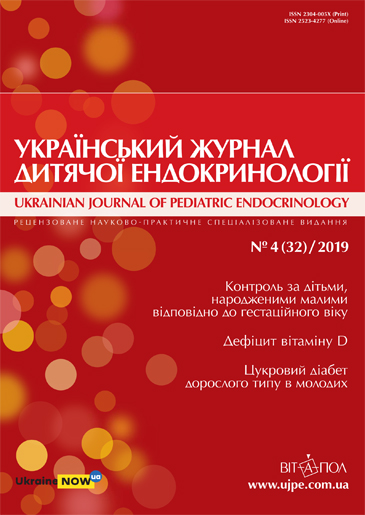Цукровий діабет дорослого типу в молодих: від генетики до практики. Частина 2
DOI:
https://doi.org/10.30978/UJPE2019-4-17Ключові слова:
цукровий діабет дорослого типу у молодих, фактори транскрипції, препарати сульфонілсечовини, дітиАнотація
Цукровий діабет дорослого типу у молодих (maturity onset type diabetes of young people (MODY)) являє собою гетерогенну групу захворювань з автосомно-домінантним типом успадкування, які зумовлені мутаціями генів, що беруть участь у синтезі та секреції інсуліну. MODY є найпоширенішою групою моногенних форм цукрового діабету. Наведено огляд літератури, присвяченої MODY з порушенням факторів транскрипції (hepatocyte nuclear factors) HNF4A і HNF1A (MODY 1 і 3). Мутації генів HNF1A і HNF4A призводять до порушення експресії протеїнів, які беруть участь у транспорті та метаболізмі глюкози, синтезі та секреції інсуліну. Ці підтипи MODY розвиваються в пубертатному або постпубертатному віці і характеризуються зменшенням базальної та постпрандіальної секреції інсуліну. Прогресуюче погіршення функції β-клітин підшлункової залози пов’язане зі зниженою проліферацією і прискореним апоптозом острівцевих клітин. Особливостями HNF4A-MODY є макросомія при народженні (в 56 % випадків) і гіперінсулінемічна гіпоглікемія в період новонародженості (в 15 % випадків). Важлива ознака HNF1A/HNF4A-MODY — висока чутливість до препаратів сульфонілсечовини. Секреція інсуліну щорічно знижується на 1 — 4 %, тому через кілька років пацієнти стають резистентними до препаратів сульфонілсечовини і потребують інсулінотерапії. При застосуванні препаратів сульфонілсечовини у пацієнтів відмічено високий ризик розвитку гіпоглікемічних станів. Розглянуто альтернативні методи лікування HNF1A/HNF4A MODY: аналоги меглітиніду, агоністи глюкагоноподібного пептиду-1 та інгібітори дипептидилпептидази-4. На тлі використання цих лікарських препаратів частота гіпоглікемічних станів нижча порівняно із застосуванням агоністів сульфонілсечовини. Ризик розвитку мікросудинних ускладнень у пацієнтів з HNF1A/HNF4A-MODY залежить від якості контролю глікемії.
Посилання
Amed S, Oram R Maturity-Onset Diabetes of the Young (MODY): Making the right diagnosis to optimize treatment. Canadian Journal of Diabetes. 2016;40:449-454. doi: 10.1016/j.jcjd.2016.03.002.
Andersen A, Lund A, Knop FK. Glucagon-like peptide 1 in health and disease. Nature Reviews Endocrinology. 2018;14:390-403. doi: 10.1038/s41574-018-0016-2.
Anık A, Çatlı G, Abacı A. Maturity-onset diabetes of the young (MODY): an update. J Pediatr-Endocrinol. Metab. 2015;28(3-4):251-263.
Arya VB, Rahman S, Senniappan S. HNF4A mutation: switch from hyperinsulinaemichypoglycaemia to maturity-onset diabetes of the young, and incretin response. Diabet Med. 2014;31:11-15. doi: 10.1515/jpem-2014-0384.
Bacon S, Kyithar MP, Condron EM. Prolonged episodes of hypoglycaemia in HNF4A-MODY mutation carriers with IGT. Evidence of persistent hyperinsulinism into early adulthood. Acta Diabetologica. 2016;53:965-972. doi: 10.1007/s00592-016-0890-9.
Becker M, Galler A, Raile K. Meglitinide analogues in adolescent patients with HNF1A-MODY (MODY 3). Pediatrics. 2014;133:775-779. doi: 10.1542/peds.2012-2537.
Bellanné-Chantelot C, Carette C, Riveline JP. The type and the position of HNF1A mutation modulate age at diagnosis of diabetes in patients with maturity onset diabetes of the young (MODY)-3. Diabetes. 2008;57:503-508. 10.2337/db07-0859.
Docena MK, Faiman C, Stanley CM. Mody-3: novel HNF1A mutation and the utility of glucagon-like peptide (GLP)-1 receptor agonist therapy. Endocr Pract. 2014;20:107-111. doi: 10.4158/EP13254.OR.
Gardner DS, Tai ES. Clinical features and treatment of maturity onset diabetes of the young (MODY). Diabetes Metab. Syndr Obes. 2012;5:101-108. doi: 10.2147/DMSO.S23353.
Girard R, Darsigny M, Jones C. HNF4α is a novel regulator of intestinal glucose-dependent insulinotropic polypeptide. Sci Rep. 2019;12:1200. doi: 10.1038/s41598-019-41061-z.
Guardado-Mendoza R, Prioletta A, Jiménez-Ceja LM. The role of nateglinide and repaglinide, derivatives of meglitinide, in the treatment of type 2 diabetes mellitus. Arch Med Sci. 2013;9:936-943. doi: 10.5114/aoms.2013.34991
Kyithar MP, Bonner C, Bacon S. Effects of hepatocyte nuclear factor-1A and -4A on pancreatic stone protein/regenerating protein and C-reactive protein gene expression: implications for maturity-onset diabetes of the young. J Transl. Med. 2013;11:156. doi: 10.1186/1479-5876-11-156.
Laver TW, Colclough K, Shepherd M. The Common p.R114W HNF4A mutation causes a distinct clinical subtype of monogenic diabetes. Diabetes. 2016;65:3212-3217. doi: 10.2337/db16-0628.
Nagashima K, Takahashi A, Ikeda H. Sulfonylurea and non-sulfonylurea hypoglycemic agents: pharmachological properties and tissue selectivity. Diabetes Research and Clinical Practice. 2004;66:75-78. DOI: 10.1016/j.diabres.2003.12.011. doi: 10.1016/j.diabres.2003.12.011.
Østoft SH, Bagger JI, Hansen T. Glucose-lowering effects and low risk of hypoglycemia in patients with maturity-onset diabetes of the young when treated with a GLP-1 receptor agonist: a double-blind, randomized, crossover trial. Diabetes Care. 2014;37:1797-1805. doi: 10.2337/dc13-3007.
Owen KR, Thanabalasingham G, James TJ. Assessment of high-sensitivity C-reactive protein levels as diagnostic discriminator of maturity-onset diabetes of the young due to HNF1A mutations. Diabetes Care. 2010;33:1919-1924. doi: 10.2337/dc10-0288.
Pontoglio M, Prié D, Cheret C. HNF1 alpha controls renal glucose reabsorption in mouse and man. EMBO Rep. 2000;4:359-365. DOI: 10.1093/embo-reports/kvd071.
Sanyoura M, Philipson LH, Naylor R. Monogenic diabetes in children and adolescents: recognition and treatment options. Curr Diab Rep. 2018;18:58. doi: 10.1007/s11892-018-1024-2.
Seino Y, Fukushima M, Yabe D. GIP and GLP-1, the two incretin hormones: Similarities and differences. J Diabetes Investig. 2010;22:8-23. doi: 10.1111/j.2040-1124.2010. 00022.x. doi: 10.1111/j.2040-1124.2010.00022.x.
Shepherd MH, Shields BM, Hudson M. A UK nationwide prospective study of treatment change in MODY: genetic subtype and clinical characteristics predict optimal glycaemic control after discontinuing insulin and metformin. Diabetologia. 2018;61:2520-2527. doi: 10.1007/s00125-018-4728-6.
Shibasaki T, Takahashi T, Takahashi H. Cooperation between cAMPsignalling and sulfonylurea in insulin secretion. Diabetes, Obesity and Metabolism. 2014;16:118-125. doi: 10.1111/dom.12343. doi: 10.1111/dom.12343.
Steele AM, Shields BM, Shepherd M. Increased all-cause and cardiovascular mortality in monogenic diabetes as a result of mutations in the HNF1A gene. Diabet Med. 2010;7:157-161. doi: 10.1111/j.1464-5491.2009.02913.x.
Tonouchi R, Mine Y, Aoki M. Efficacy and safety of alogliptin in a pediatric patient with maturity-onset diabetes of the young type 1. Clin Pediatr Endocrinol. 2017;26:183-188. doi: 10.1297/cpe.26.183.
Urakami T, Habu M, Okuno M. Three years of liraglutide treatment offers continuously optimal glycemic control in a pediatric patient with maturity-onset diabetes of the young type 3. J Pediatr. Endocrinol Metab. 2015;28:327-31. doi: https://doi.org/10.1515/jpem-2014-0211.
Winkler M, Stephan D Bieger S, Kühner P. Testing the bipartite model of the sulfonylurea receptor binding site: binding of A-, B-, and A + B-site ligands. J Pharmacol Exp Ther. 2007;322:701-708. doi: 10.1124/jpet.107.123224.
Yamagata K. Roles of HNF1α and HNF4α in Pancreatic β-Cells. Vitamins & Hormones. 2014;1:407-423. doi: 10.1016/B978-0-12-800174-5.00016-8.





